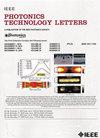Integrated Photonic Convolution Accelerator Empowered by Thin-Film Lithium Niobate Modulators
IF 2.3
3区 工程技术
Q2 ENGINEERING, ELECTRICAL & ELECTRONIC
引用次数: 0
Abstract
The current optical convolution architectures are facing challenges related to limited scalability, excessive data redundancy and restricted processing bandwidth. In this work, we introduce an integrated photonic convolution accelerator (IPCA) empowered by high-speed thin-film lithium niobate (LN) modulators. Consequently, data replication redundancy is free and Fourier transform is avoided, which paves the way for highly efficient convolution scaling. We implement convolution in an optical frequency spacing of 8 GHz with a power consumption of only 52.9 mW. Optical neural networks of different parameter sizes are constructed across various complex tasks. Given its advantages to address energy consumption and computing power challenges inherent to current AI advancements, our method heralds a pivotal shift in upcoming optical computing hardware architectures.薄膜铌酸锂调制器支持的集成光子卷积加速器
当前的光学卷积架构面临着可扩展性受限、数据冗余和处理带宽受限等挑战。在这项工作中,我们介绍了一种由高速薄膜铌酸锂(LN)调制器驱动的集成光子卷积加速器(IPCA)。因此,数据复制冗余是自由的,避免了傅里叶变换,为高效的卷积缩放铺平了道路。我们在8 GHz的光学频率间隔内实现卷积,功耗仅为52.9 mW。不同参数大小的光神经网络被构建在各种复杂的任务中。鉴于其在解决当前人工智能进步所固有的能耗和计算能力挑战方面的优势,我们的方法预示着即将到来的光学计算硬件架构的关键转变。
本文章由计算机程序翻译,如有差异,请以英文原文为准。
求助全文
约1分钟内获得全文
求助全文
来源期刊

IEEE Photonics Technology Letters
工程技术-工程:电子与电气
CiteScore
5.00
自引率
3.80%
发文量
404
审稿时长
2.0 months
期刊介绍:
IEEE Photonics Technology Letters addresses all aspects of the IEEE Photonics Society Constitutional Field of Interest with emphasis on photonic/lightwave components and applications, laser physics and systems and laser/electro-optics technology. Examples of subject areas for the above areas of concentration are integrated optic and optoelectronic devices, high-power laser arrays (e.g. diode, CO2), free electron lasers, solid, state lasers, laser materials'' interactions and femtosecond laser techniques. The letters journal publishes engineering, applied physics and physics oriented papers. Emphasis is on rapid publication of timely manuscripts. A goal is to provide a focal point of quality engineering-oriented papers in the electro-optics field not found in other rapid-publication journals.
 求助内容:
求助内容: 应助结果提醒方式:
应助结果提醒方式:


